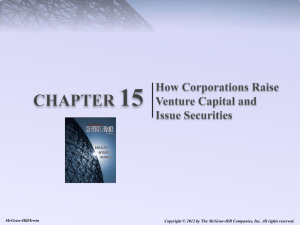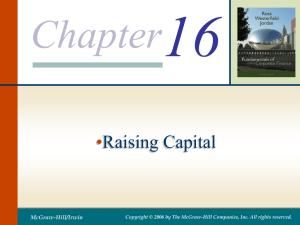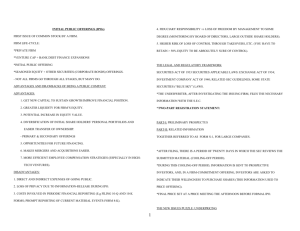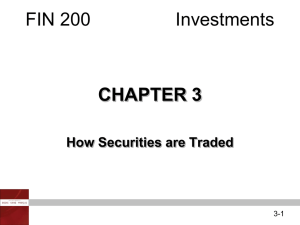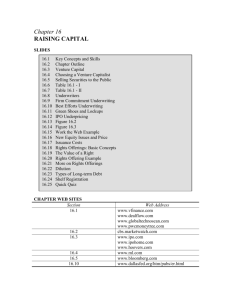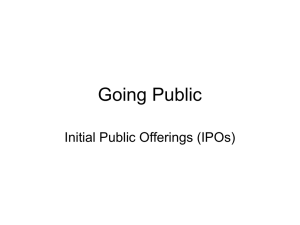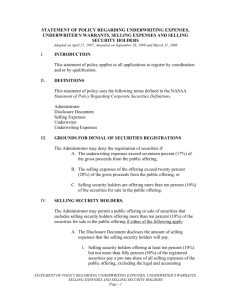Rights Issue
advertisement
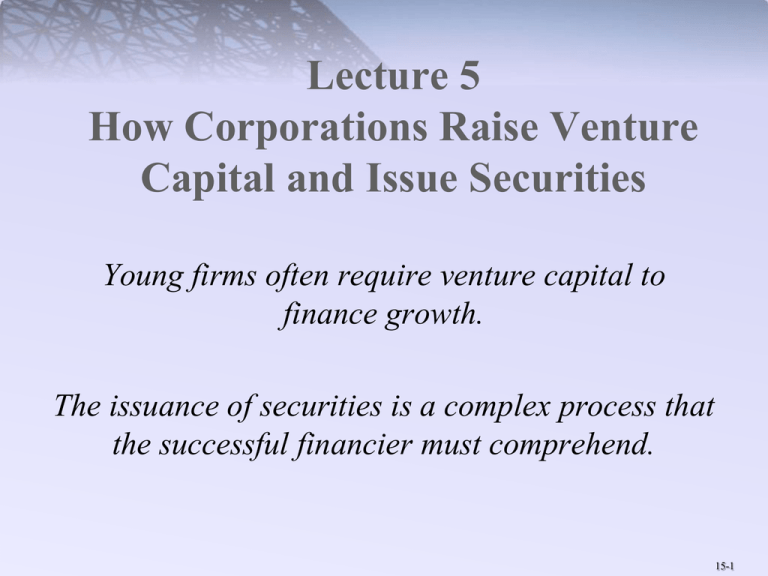
Lecture 5 How Corporations Raise Venture Capital and Issue Securities Young firms often require venture capital to finance growth. The issuance of securities is a complex process that the successful financier must comprehend. 15-1 Company Growth Venture Capital provides entrepreneurs with financing to grow their firms. Firms issue securities to further finance their growth. 15-2 Obtaining Venture Capital Steps to obtaining venture funding: 1. Prepare a business plan. • Business Plan – A description of a firm’s products, market, production methods, and resources needed for success. • Staged Financing – Venture capital is rarely disbursed in one large lump sum payment, but instead is paid to the firm in stages. Each stage is usually just enough to guide the firm towards its next major checkpoint. 1. Receive first-stage financing. 2. Receive subsequent staged financing. 15-3 Venture Capital Ownership: Example Suppose a Venture Capital firm offers to purchase 1 million of your firm’s shares for $1 each, which will give them 50% ownership in the firm. What value are they placing on your firm? Value of the Firm = $1, 000, 000 $2, 000, 000 .50 15-4 Types of Venture Investors Angel Investors • Investors who finance companies in their earliest stages of growth Corporate Venturers • Corporations that offer venture assistance to finance young, promising companies. Private Equity Investing • Investors who offer funds to finance firms that do not trade on public stock exchanges such as the NYSE or NASDAQ. 15-5 Venture Capital Management Venture Capitalist are not passive investors. What do they provide beyond financing? 15-6 The Initial Public Offering When a firm requires more capital than private investors can provide, it can choose to go public through an Initial Public Offering, or IPO. Primary Offering – when new shares are sold to raise additional cash for the company Secondary Offering – when the company’s founders and venture capitalists cash in on some of their gains by selling shares. Does a secondary offering provide additional capital to the firm? 15-7 Benefits of Going Public Ability to raise new capital Stock price provides performance measure Information more widely available 15-8 Benefits of Going Public Diversified sources of finance Reduced borrowing costs 15-9 Arranging Public Issues Steps to issue a new public security: SEC Registration 1. • Prospectus—a formal summary that provides information on an issue of securities 2. Select Underwriter / Undertake Roadshow 3. Set final issue price for public •The roadshow attempts to gauge the interest that potential investors would have in purchasing the new securities. •If enough public interest, the underwriters issue shares to the public. Typically underwriters underprice shares upon issue. • Underpricing – Issuing securities at an offering price set below the true value of the security. 15-10 IPO Flowchart 1 Underwriter 2 Firm Investors 3 4 1. 2. 3. 4. 5. 5 Underwriter provides advice to firm Underwriter pays firm for a number of shares Firm provides shares to underwriter to be resold Underwriter offers shares to investors Investors purchase shares from underwriter 15-11 Underwriter Spread Spread - the difference between the public offer price and the price paid by underwriter Assume the issuing company incurs $1 million in expenses to sell 3 million shares at $40 each to an underwriter; the underwriter sells the shares at $43 each. What is the spread for this deal? 15-12 Underwriting Arrangements Firm Commitment: Underwriters buy the securities from the firm and then resell them to the public. Best Efforts Commitment: Underwriters agree to sell as much of the issue as possible but do not guarantee the sale of the entire issue. 15-13 Underwriting Arrangements: Capital To Firm How much will a firm receive in net funding from a firm commitment underwriting of 250,000 shares priced to the public at $40 if a 10% underwriting spread has been added to the price paid by the underwriter? Additionally, the firm pays $600,000 in legal fees. 15-14 Underpricing of an IPO Underpricing: Issuing securities at an offering price set below the true value of the security. Example: Assume the issuer incurs $1 million in other expenses to sell 3 million shares at $40 each to an underwriter and the underwriter sells the shares at $43 each. By the end of the first day’s trading, the issuing company’s stock price had risen to $70. What is the total cost of underpricing? Cost of Underpricing: 15-15 Flotation Costs Flotation Costs: The costs incurred when a firm issues new securities to the public. What are some of the specific costs incurred when a firm issues new securities? 15-16 Types of Offerings After the IPO, successful firms may issue additional equity or debt. Seasoned Offering:– Sale of securities by a firm that is already publicly traded. Rights Issue Issue of securities offered only to current stockholders. General Cash Offer Sale of securities open to all investors by an already-public company. 15-17 Rights Issue: Example An investor exercises his right to buy one additional share at $20 for every five shares held. How much should each share be worth after the rights issue if they previously sold for $50 each? Pre-Rights Issue: Post-Rights Issue: + 15-18 General Cash Offer and Shelf Registration Shelf Registration: A procedure that allows firms to file one registration statement for several issues of the same security. 1. 2. 3. 4. Benefits of Shelf Registration: Security issuance without excessive costs Security issuance on very short notice Timed issuance to capitalize on favorable market conditions Additional underwriter competition 15-19 Private Placements In order to avoid registering with the SEC, a company can issue a security privately. Private Placement: The sale of securities to a limited number of investors without a public offering 15-20 Private Placements-Advantages Do not have to register with SEC Private placements cost less than public issues Contracts can be customized for each investor 15-21 Private PlacementsDisadvantages Difficult for investors to resell security Lenders often require higher return to compensate for higher risk. • Private placements typically yield .5% higher than public issues 15-22
